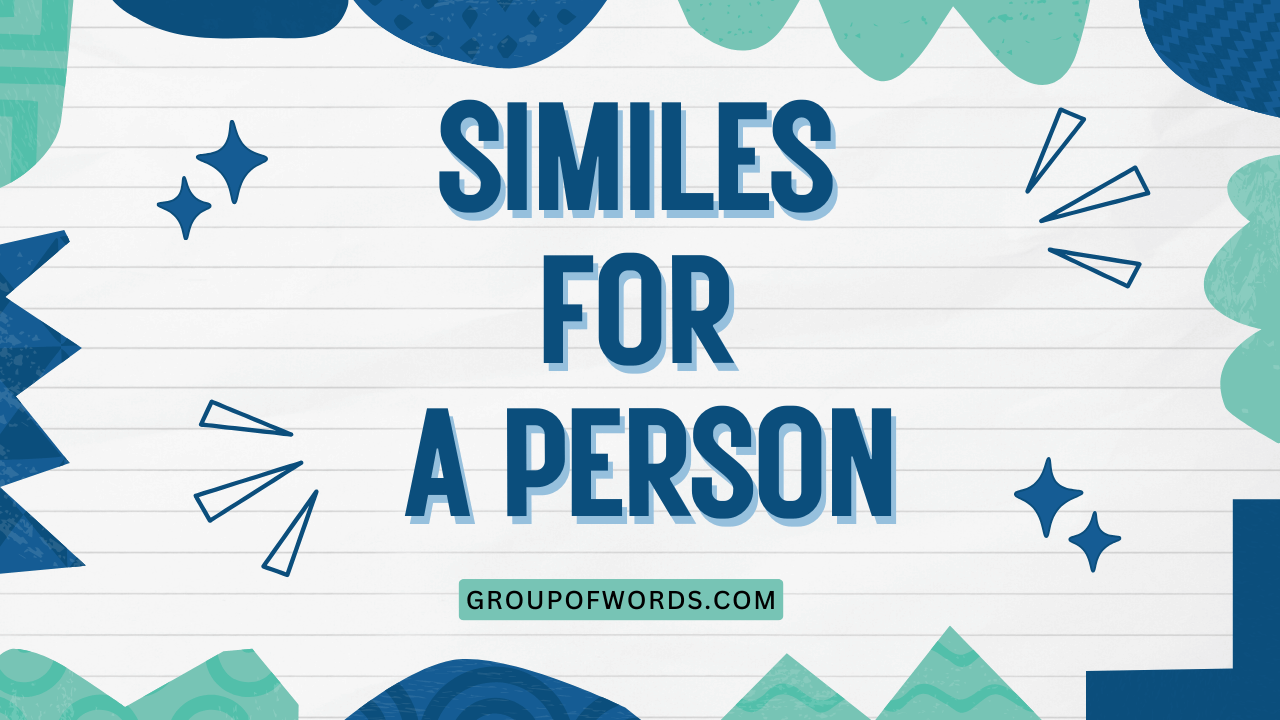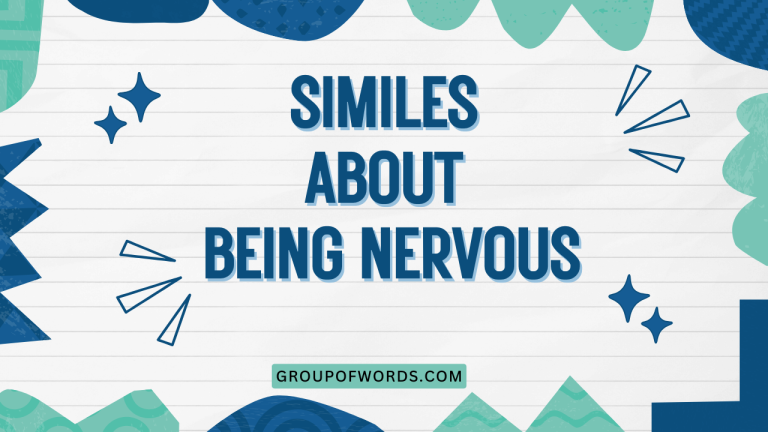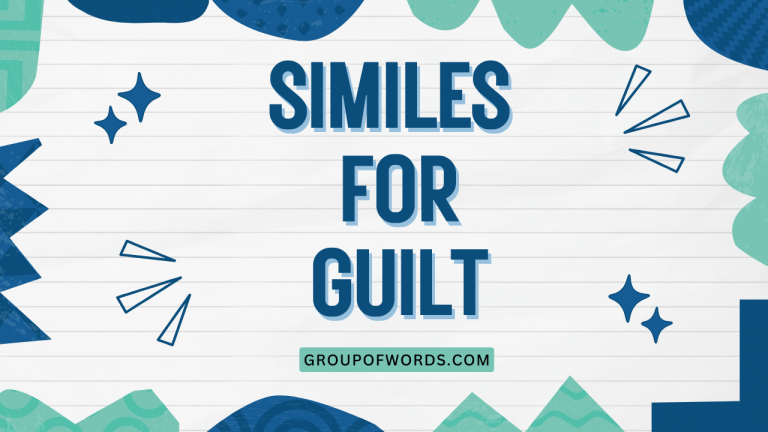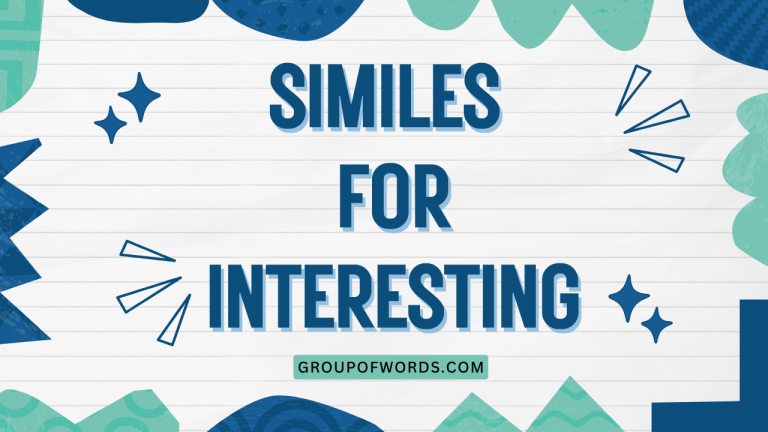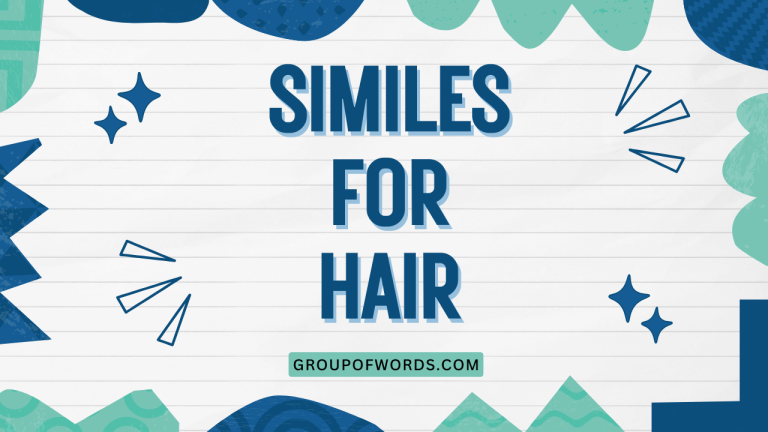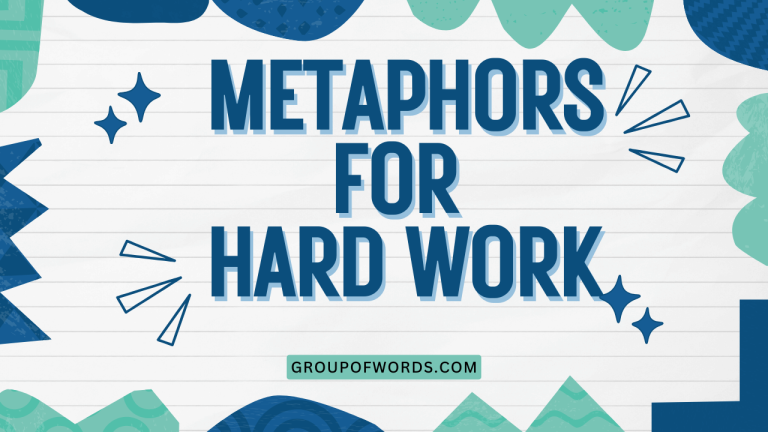Similes for a Person: Enhancing Descriptions with Figurative Language
Similes are powerful tools in the English language that allow us to create vivid and engaging descriptions. By comparing a person to something else, we can highlight specific qualities and paint a more compelling picture in the reader’s mind.
Understanding how to effectively use similes can greatly enhance your writing and communication skills. This article will delve into the definition, structure, types, and usage of similes specifically tailored for describing people.
Whether you’re a student, writer, or simply someone looking to improve their language skills, this guide will provide you with the knowledge and practice you need to master this essential aspect of figurative language.
This comprehensive guide is designed for English language learners of all levels, from beginners to advanced students. We’ll cover the basics of simile construction, explore various examples, and provide practical exercises to solidify your understanding.
Table of Contents
- Definition of Simile
- Structural Breakdown of Similes
- Types of Similes for Describing People
- Examples of Similes for a Person
- Usage Rules for Similes
- Common Mistakes with Similes
- Practice Exercises
- Advanced Topics in Similes
- Frequently Asked Questions
- Conclusion
Definition of Simile
A simile is a figure of speech that directly compares two different things using the words “like” or “as.” The purpose of a simile is to make a description more vivid and relatable by drawing a connection between the person or object being described and something familiar to the audience. Similes are essential for adding color and depth to writing, allowing authors to convey complex ideas and emotions in a concise and impactful way.
Unlike metaphors, which imply that one thing *is* another, similes explicitly state a comparison. This direct comparison makes similes a more accessible and straightforward tool for writers of all levels.
Similes are prevalent in both formal and informal writing, as well as in everyday speech.
The function of a simile is to enhance understanding and create a stronger image in the reader’s mind. By comparing a person to something else, we can highlight specific qualities or characteristics that might otherwise be overlooked.
For example, saying someone is “as brave as a lion” immediately conveys a sense of courage and fearlessness.
Structural Breakdown of Similes
The basic structure of a simile typically includes the following elements:
- The Subject: The person or thing being described.
- The Comparison Word: “Like” or “as.”
- The Object of Comparison: The thing to which the subject is being compared.
- The Shared Quality: The characteristic that the subject and object of comparison have in common.
Let’s break down a simple example: “She is as graceful as a swan.”
- Subject: She
- Comparison Word: as
- Object of Comparison: a swan
- Shared Quality: Gracefulness
Understanding this structure helps in creating effective similes. By carefully selecting the object of comparison and highlighting the shared quality, you can create a powerful and memorable image for your reader.
Similes can also be more complex, incorporating additional descriptive words and phrases to further enhance the comparison. However, the core structure remains the same: a subject, a comparison word, an object of comparison, and a shared quality.
Types of Similes for Describing People
Similes can be categorized based on the aspects of a person they describe. Here are some common types:
Similes Describing Appearance
These similes focus on physical attributes, such as height, weight, complexion, or features. They help create a visual picture of the person being described.
Similes Describing Personality
These similes delve into character traits, such as bravery, kindness, intelligence, or humor. They provide insight into the person’s inner qualities.
Similes Describing Behavior
These similes focus on how a person acts or reacts in certain situations. They reveal patterns of behavior and tendencies.
Similes Describing Emotions
These similes express the person’s feelings, such as happiness, sadness, anger, or fear. They convey the emotional state of the individual.
Similes Describing Skills or Abilities
These similes highlight a person’s talents or capabilities, such as their musical ability, athletic prowess, or artistic skills. They showcase their strengths and expertise.
Examples of Similes for a Person
Here, we’ll explore numerous examples of similes, categorized by the aspect of the person they describe. Each example aims to provide a clear and vivid comparison.
Examples Describing Appearance
The following table provides examples of similes used to describe a person’s appearance. These similes use comparisons to create a visual image in the reader’s mind.
| Simile | Explanation |
|---|---|
| She is as radiant as the sun. | Describes a bright and glowing appearance. |
| He is as tall as a tree. | Describes someone with great height. |
| Her skin is as smooth as silk. | Describes very soft and flawless skin. |
| His eyes are like sparkling jewels. | Describes bright and attractive eyes. |
| She is as thin as a rail. | Describes someone very slender. |
| He was as broad as a barn door. | Describes a very wide or large person. |
| Her hair is like spun gold. | Describes light-colored, fine hair. |
| His face was as red as a beet. | Describes a flushed or embarrassed face. |
| She looked as delicate as a porcelain doll. | Describes a fragile and beautiful appearance. |
| He stood as solid as a rock. | Describes a sturdy and strong build. |
| Her smile was as bright as a summer day. | Describes a cheerful and radiant smile. |
| His hands were as rough as sandpaper. | Describes coarse and calloused hands. |
| She moved as gracefully as a swan on water. | Describes elegant and fluid movements. |
| He was as pale as a ghost. | Describes a very white or colorless complexion. |
| Her eyes were as blue as the summer sky. | Describes vividly blue eyes. |
| He was as round as a beach ball. | Describes a plump or overweight person. |
| Her features were as sharp as knives. | Describes distinct and angular facial features. |
| He was as handsome as a movie star. | Describes someone very attractive. |
| She looked as fresh as a daisy. | Describes a youthful and vibrant appearance. |
| He was as wrinkled as a prune. | Describes a face with many wrinkles. |
Examples Describing Personality
This table showcases similes that illustrate various aspects of a person’s personality. These comparisons help convey the individual’s character traits and inner qualities.
| Simile | Explanation |
|---|---|
| He is as brave as a lion. | Describes someone courageous and fearless. |
| She is as gentle as a lamb. | Describes someone kind and mild-mannered. |
| He is as stubborn as a mule. | Describes someone very resistant to change. |
| She is as wise as an owl. | Describes someone knowledgeable and insightful. |
| He is as sly as a fox. | Describes someone cunning and deceptive. |
| She is as cheerful as a lark. | Describes someone happy and optimistic. |
| He is as quiet as a mouse. | Describes someone shy and reserved. |
| She is as innocent as a dove. | Describes someone pure and naive. |
| He is as generous as the day is long. | Describes someone exceptionally giving. |
| She is as patient as a saint. | Describes someone extremely tolerant. |
| He is as quick-witted as a comedian. | Describes someone with a sharp and humorous mind. |
| She is as organized as a filing cabinet. | Describes someone meticulously organized. |
| He is as dependable as the sunrise. | Describes someone reliable and trustworthy. |
| She is as adaptable as a chameleon. | Describes someone who can easily adjust to new situations. |
| He is as ambitious as a CEO. | Describes someone highly driven and goal-oriented. |
| She is as empathetic as a counselor. | Describes someone who understands and shares the feelings of others. |
| He is as meticulous as a surgeon. | Describes someone extremely careful and precise. |
| She is as creative as an artist. | Describes someone imaginative and inventive. |
| He is as persistent as a salesman. | Describes someone who doesn’t give up easily. |
| She is as confident as a runway model. | Describes someone self-assured and poised. |
Examples Describing Behavior
The following table presents similes that describe a person’s behavior in different situations. These comparisons help to illustrate how someone typically acts or reacts.
| Simile | Explanation |
|---|---|
| He eats like a horse. | Describes someone who eats a large amount of food. |
| She sings like an angel. | Describes someone with a beautiful singing voice. |
| He works like a dog. | Describes someone who works very hard. |
| She runs like the wind. | Describes someone who runs very fast. |
| He sleeps like a log. | Describes someone who sleeps soundly. |
| She gossips like a magpie. | Describes someone who talks a lot, especially about others. |
| He fights like a tiger. | Describes someone who fights fiercely. |
| She dances like a dream. | Describes someone who dances beautifully. |
| He argues like a lawyer. | Describes someone skilled at debating and arguing. |
| She worries like a mother hen. | Describes someone who is overly concerned and protective. |
| He follows instructions like a robot. | Describes someone who follows directions precisely and without question. |
| She shops like there’s no tomorrow. | Describes someone who spends money excessively. |
| He drives like a maniac. | Describes someone who drives recklessly. |
| She plans like a general. | Describes someone who is very strategic and organized in their planning. |
| He procrastinates like a student. | Describes someone who delays tasks or duties. |
| She manages her time like a CEO. | Describes someone who is very efficient and organized in managing their time. |
| He complains like a toddler. | Describes someone who whines and complains frequently. |
| She handles pressure like a diamond. | Describes someone who remains strong and resilient under stress. |
| He learns like a sponge. | Describes someone who absorbs information quickly and easily. |
| She remembers everything like an elephant. | Describes someone with a very good memory. |
Examples Describing Emotions
This table features similes that convey a person’s emotional state. These comparisons help to express feelings such as happiness, sadness, anger, and fear.
| Simile | Explanation |
|---|---|
| He was as happy as a clam. | Describes someone very content and pleased. |
| She was as sad as a rainy day. | Describes someone feeling gloomy and depressed. |
| He was as angry as a hornet. | Describes someone very irritated and easily provoked. |
| She was as scared as a mouse. | Describes someone feeling very frightened. |
| He was as nervous as a long-tailed cat in a room full of rocking chairs. | Describes someone extremely anxious and uneasy. |
| She felt as light as a feather. | Describes someone feeling carefree and happy. |
| He was as excited as a kid on Christmas morning. | Describes someone feeling thrilled and eager. |
| She was as lonely as a cloud. | Describes someone feeling isolated and alone. |
| He was as calm as a still pond. | Describes someone feeling peaceful and serene. |
| She was as frustrated as a cat trying to do long division. | Describes someone feeling annoyed and impatient. |
| He was as hopeful as a lottery winner. | Describes someone feeling optimistic and positive. |
| She was as grateful as a rescued puppy. | Describes someone feeling appreciative and thankful. |
| He felt as empty as a deserted house. | Describes someone feeling hollow and devoid of emotion. |
| She was as jealous as a hawk. | Describes someone feeling envious and possessive. |
| He was as confused as a chameleon in a bag of Skittles. | Describes someone feeling bewildered and disoriented. |
| She was as content as a cat in a sunbeam. | Describes someone feeling satisfied and comfortable. |
| He was as bitter as a lemon. | Describes someone feeling resentful and cynical. |
| She was as nostalgic as an old photograph. | Describes someone feeling sentimental about the past. |
| He was as relieved as a prisoner set free. | Describes someone feeling liberated and unburdened. |
| She was as overwhelmed as a student during finals week. | Describes someone feeling stressed and overburdened. |
Examples Describing Skills or Abilities
This table provides examples of similes used to describe a person’s skills or abilities. These comparisons highlight their talents and expertise.
| Simile | Explanation |
|---|---|
| He paints like a master. | Describes someone with exceptional painting skills. |
| She sings like a nightingale. | Describes someone with a beautiful singing voice. |
| He plays basketball like a pro. | Describes someone with excellent basketball skills. |
| She writes like Shakespeare. | Describes someone with exceptional writing abilities. |
| He cooks like a gourmet chef. | Describes someone with excellent culinary skills. |
| She teaches like a natural. | Describes someone who is a gifted teacher. |
| He leads like a general. | Describes someone who is a strong and effective leader. |
| She designs like an architect. | Describes someone with exceptional design skills. |
| He repairs things like an engineer. | Describes someone skilled at fixing and repairing things. |
| She negotiates like a diplomat. | Describes someone skilled at negotiation and diplomacy. |
| He dances like Fred Astaire. | Describes someone who dances with great skill and elegance. |
| She speaks languages like a linguist. | Describes someone who is fluent in many languages. |
| He solves problems like Sherlock Holmes. | Describes someone who is very good at solving complex problems. |
| She manages projects like a seasoned professional. | Describes someone who is highly skilled at project management. |
| He builds websites like a coding genius. | Describes someone who is exceptionally skilled at web development. |
| She plays the piano like a concert pianist. | Describes someone who is highly skilled at playing the piano. |
| He drives a race car like a champion. | Describes someone who is skilled at race car driving. |
| She writes code like a computer scientist. | Describes someone who is highly skilled at writing computer code. |
| He analyzes data like a statistician. | Describes someone who is skilled at analyzing data. |
| She presents information like a motivational speaker. | Describes someone who is very good at public speaking and inspiring others. |
Usage Rules for Similes
While similes are relatively straightforward, there are a few key rules to keep in mind to ensure their effective use:
- Clarity: The comparison should be clear and easily understood by the reader. Avoid obscure or overly complex comparisons.
- Relevance: The object of comparison should have a clear connection to the subject being described. The shared quality should be evident.
- Originality: While common similes can be effective, strive for originality to make your writing more engaging and memorable.
- Context: Ensure that the simile is appropriate for the context of your writing. Consider the tone and audience.
It’s also important to avoid clichéd similes, which are overused and have lost their impact. Examples of clichéd similes include “as blind as a bat” or “as busy as a bee.”
When using similes, consider the connotations of the object of comparison. Different objects can evoke different emotions and associations.
Choose objects that align with the intended meaning and tone of your writing.
Common Mistakes with Similes
Even with a clear understanding of similes, it’s easy to make mistakes. Here are some common errors to avoid:
- Using Metaphors Instead of Similes: Confusing similes with metaphors is a common mistake. Remember that similes use “like” or “as” to make a direct comparison, while metaphors imply that one thing *is* another.
- Creating Unclear Comparisons: If the reader cannot easily understand the connection between the subject and the object of comparison, the simile is ineffective.
- Using Clichéd Similes: Overused similes lack originality and can make your writing seem uninspired.
- Using Illogical Comparisons: The comparison should make sense. Comparing unrelated things can be confusing and detract from your message.
| Incorrect | Correct | Explanation |
|---|---|---|
| He is a lion. | He is as brave as a lion. | The first example is a metaphor, while the second is a simile. |
| She is like a purple elephant. | She is as graceful as a swan. | The first example is illogical, while the second makes a clear comparison. |
| He is as busy as a bee. | He is as industrious as an ant. | The first example is a cliché, while the second is more original. |
Practice Exercises
Test your understanding of similes with these practice exercises. Fill in the blanks to complete the similes, or rewrite the sentences using similes.
Exercise 1: Fill in the Blanks
Complete the following sentences with appropriate similes.
| Question | Answer |
|---|---|
| 1. He runs ____________. | He runs like the wind. |
| 2. She sings ____________. | She sings like an angel. |
| 3. He is as stubborn as ____________. | He is as stubborn as a mule. |
| 4. She is as gentle as ____________. | She is as gentle as a lamb. |
| 5. He eats ____________. | He eats like a horse. |
| 6. She sleeps ____________. | She sleeps like a log. |
| 7. He is as quiet as ____________. | He is as quiet as a mouse. |
| 8. She is as wise as ____________. | She is as wise as an owl. |
| 9. He is as sly as ____________. | He is as sly as a fox. |
| 10. She is as happy as ____________. | She is as happy as a clam. |
Exercise 2: Rewrite the Sentences
Rewrite the following sentences using similes.
| Question | Answer |
|---|---|
| 1. He is very brave. | He is as brave as a lion. |
| 2. She is very beautiful. | She is as radiant as the sun. |
| 3. He is very tall. | He is as tall as a tree. |
| 4. She is very fast. | She runs like the wind. |
| 5. He is very strong. | He is as strong as an ox. |
| 6. She is very graceful. | She moves as gracefully as a swan. |
| 7. He is very intelligent. | He is as smart as a whip. |
| 8. She is very energetic. | She is as energetic as a hummingbird. |
| 9. He is very loud. | He roars like a lion. |
| 10. She is very sweet. | She is as sweet as honey. |
Exercise 3: Create Your Own Similes
Create your own similes to describe the following people/characters:
| Character | Your Simile |
|---|---|
| A hardworking student | He works like a machine, never stopping until the task is complete. |
| A talented musician | She plays the guitar like a virtuoso, effortlessly creating beautiful melodies. |
| A caring nurse | She treats her patients as gently as a mother cares for her child. |
| A strict teacher | He is as stern as a judge, ensuring every student follows the rules. |
| A funny comedian | He tells jokes as naturally as breathing, always making people laugh. |
| A creative artist | She paints as passionately as a lover pouring her heart out. |
| A brave soldier | He fights as courageously as a knight defending his kingdom. |
| A wise leader | She guides her team as skillfully as a captain navigating a ship. |
| A dedicated athlete | He trains as relentlessly as a marathon runner preparing for the race. |
| An honest friend | She is as truthful as the day is long, always giving sincere advice. |
Advanced Topics in Similes
For advanced learners, it’s beneficial to explore more nuanced aspects of similes:
- Extended Similes: These are longer and more detailed similes that expand on the comparison, providing a richer and more complex image.
- Subverted Similes: These are similes that intentionally break the expected pattern, often for humorous or ironic effect.
- Cultural Context: Understanding the cultural context of similes is crucial, as certain comparisons may have different meanings or connotations in different cultures.
Experimenting with different types of similes and paying attention to cultural nuances can significantly enhance your writing and communication skills.
Advanced writers use similes not just for description, but also to create tone, mood, and thematic resonance. A well-crafted simile can subtly hint at deeper meanings and enrich the overall narrative.
Frequently Asked Questions
Here are some frequently asked questions about similes:
- What is the difference between a simile and a metaphor?
A simile directly compares two things using “like” or “as,” while a metaphor implies that one thing *is* another. Similes are more explicit, while metaphors are more implicit.
- Why are similes useful in writing?
Similes help create vivid and engaging descriptions, making your writing more interesting and relatable to the reader. They can also convey complex ideas and emotions in a concise way.
- How can I avoid using clichéd similes?
Strive for originality by thinking of unique and unexpected comparisons. Consider the specific qualities you want to highlight and choose objects of comparison that are fresh and relevant.
- Can a simile be too complex?
Yes, a simile can be too complex if the comparison is difficult to understand or if it detracts from the overall clarity of your writing. Aim for clarity and relevance in your comparisons.
- Are similes only used in writing?
No, similes are used in both writing and everyday speech. They are a common way to make descriptions more vivid and expressive.
- How do I choose the best object of comparison for a simile?
Consider the qualities you want to highlight and choose an object that clearly embodies those qualities. The object should be familiar to your audience and should evoke the desired associations.
- What is an extended simile?
An extended simile is a simile that is developed over several lines or even a paragraph. It provides more detail and depth to the comparison, creating a richer and more vivid image in the reader’s mind. Extended similes are often used to emphasize a particular point or to create a stronger emotional impact.
- Can similes be used in all types of writing?
Yes, similes can be used in various types of writing, including fiction, poetry, essays, and even technical writing. However, it’s important to use them appropriately and sparingly, ensuring that they enhance the writing rather than detract from it.
Conclusion
Mastering similes is crucial for enhancing your descriptive writing and communication skills. By understanding the definition, structure, types, and usage rules, you can effectively use similes to create vivid and engaging descriptions.
Remember to strive for clarity, relevance, and originality in your comparisons, and avoid common mistakes such as using clichéd similes or confusing similes with metaphors.
Practice using similes in your writing and pay attention to how other writers use them. With time and effort, you’ll become more adept at crafting powerful and memorable similes that enhance your writing and captivate your audience.
Keep experimenting with different types of comparisons and always consider the context and intended meaning of your writing.
